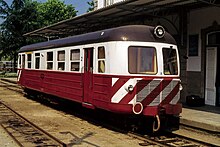NOHAB
| Industry | Engineering |
|---|---|
| Predecessor | Trollhättans Mekaniska Verkstad (1847) |
| Founded | 1916 |
| Defunct | 1979 |
| Fate | Sold to Electro Motive Division |
| Successor | Electro Motive Division |
| Headquarters | , Sweden |
| Products | Locomotives, aircraft, turbines |
NOHAB (Nydqvist & Holm AB) was a manufacturing company based in the city of Trollhättan, Sweden.
History


The company was founded by Antenor Nydqvist, Johan Magnus Lidström and Carl Olof Holm in 1847 as Trollhättans Mekaniska Verkstad as a manufacturer of turbines for hydraulic power plants. In 1865, the company made its first steam locomotive and in 1912 the 1,000th locomotive steamed out of the factory. In Nohab's anniversary book "The Thousand Locomotive" from 1912, it's mentioned that the company also manufactured davits for Titanic's lifeboats.
In 1916 the company was reconstituted as a limited company and became NOHAB. In 1920, NOHAB received an order of 1000 locomotives from Soviet Russia.[1] Only 500 were delivered between 1921 and 1924.
In 1924, Nohab built three steam locomotives, 4-6-0 ones for 1,000 mm (3 ft 3+3⁄8 in) metre gauge with the respective builder's plates #1727, #1728 and #1729 for Estrada de Ferro Rio d'Ouro in the state of Rio de Janeiro (Brazil). According to E.F. Rio d'Ouro's surviving records, they would not have arrived in Brazil before 1926.
In 1930, NOHAB started manufacturing the Bristol Jupiter aircraft engine, under licence from the Bristol Aeroplane Company. A couple of years later the aircraft engine division of NOHAB and AB Svenska järnvägsverkstäderna (Swedish Railway Workshop Limited), in Linköping, formed the aircraft manufacturer SAAB.
1930-1936 they built the Ljungström steam turbine locomotives.
In 1948 NOHAB supplied diesel railcars to the Portuguese Railways (CP), in both 1,668 mm (5 ft 5+21⁄32 in) Iberian gauge (the Série 0100) and 1,000 mm (3 ft 3+3⁄8 in) metre gauge versions (the Série 9100).
In the 1950s, NOHAB started manufacturing diesel locomotives under licence from Electro-Motive Division of General Motors.
The Danish State Railways were a major customer. 35 Di 3 were also delivered to the Norwegian State Railways.
In addition to locomotives and aircraft NOHAB was a major manufacturer of turbines for power plants and well known for medium size ship engines. NOHAB also manufactured the hulls for the S-tank.
In the 1970s, the diesel engine manufacturing facility was sold to Wärtsilä and became known as Wärtsilä Nohab.[2]
The company went bankrupt in 1979.
NOHAB in Hungary
In the early 1960s twenty NOHAB diesel engines were built for Hungarian State Railways (MÁV), but due to the Iron Curtain, further imports were stopped in favour of M62 locomotives made in Soviet Union. The Swedish locomotives were classified by MÁV as type M61 and proved versatile, highly reliable as well as economical to run. They were even used to haul non-stoppable radioactive waste transport trains from the Paks Nuclear Power Plant to Soviet reprocessing facilities, despite the availability of Soviet-made M62 engines.
The M61 type has achieved a cult status in Hungary because they were used to haul most of express trains to holiday resorts around the Lake Balaton region. Their images became closely associated with teenage summer camps, exploration and family recreation during the Socialism era, when foreign travel was highly restricted for the average citizen.
Nowadays, we can find 6+4 operational examples in Hungary. In short, to summarize their fate:
- M61 001, 020: property of the Hungarian State Railways, nostalgia vehicles, belong to the Hungarian Railway History Park, painted according to the 1963 image. They forward special trains and can be found at the head of freight trains and work trains.
- M61 006, 019: owned by MÁV Nosztalgia Kft., belong to the Hungarian Railway History Park, painted according to the last public traffic image. Freight trains and work trains are forwarded.
- M61 010 » 618 010: owned by the Nohab-GM Foundation, operates under the aegis of MTMG. Forwards special trains.
- M61 017 » A61 017 » 2761 017: property of the MÁV Track and Engineering Facilities Directorate. Locomotive equipped with a central energy supply generator (1500 V~), with a modified traction gear, capable of a speed of 120 km/h. It also transports gauge trains, special trains and a public high-speed train on weekends during the summer.
- M61 002: in the Hungarian Railway History Park, then owned by the Nohab-GM Foundation, permanently inoperable, renovation expected in the near future.
- M61 004: after the planned withdrawal, it was a vehicle designated for museum purposes. In 1993, it was painted according to its 1963 image, and from then on it also sent nostalgia and special trains. On June 4, 1999, it was damaged beyond repair in an accident caused by a falling tree at Badacsonylábdihegy. Its facade is on display at the front of the Hungarian Transport Museum until 2015.
- M61 003, 005, 007, 008, 009, 011, 012, 013, 014, 015, 016, 018: scrapped before the type was withdrawn from public circulation.
- MY 1125 » 459 021: 1957 vintage, owned by the Carpathian Railway since 2012. Forwards freight trains and work trains.
- MY 1156 » 459 022: built in 1965, owned by the Carpathian Railway since 2015. Forwards freight trains and work trains.[1]
- M61 000 » Di3.623: owned by Nohab-GM Foundation. Nohab demonstratin locomotive in Easter Europe (1960).
- 618.629 » Di 3.629: build in 1965, owned by the Komplex Rail since 2020. Forwards freight trains

- Hungarian NOHAB M61
- NOHAB Ex-DSB class MX owned now by HFHJ
- NOHAB DSB class MY
- NOHAB DSB class MZ
References
- ^ Starikov, Nikolay. "How to Make a Revolution – 2". Archived from the original on 2011-04-12. Retrieved 2011-04-11.
- ^ "Simplex-Turbulo - Nohab Polar marine diesel engine spares". Simplex Turbulo - Marine and Diesel Specialists.
External links
![]() Media related to Nydqvist & Holm AB at Wikimedia Commons
Media related to Nydqvist & Holm AB at Wikimedia Commons




